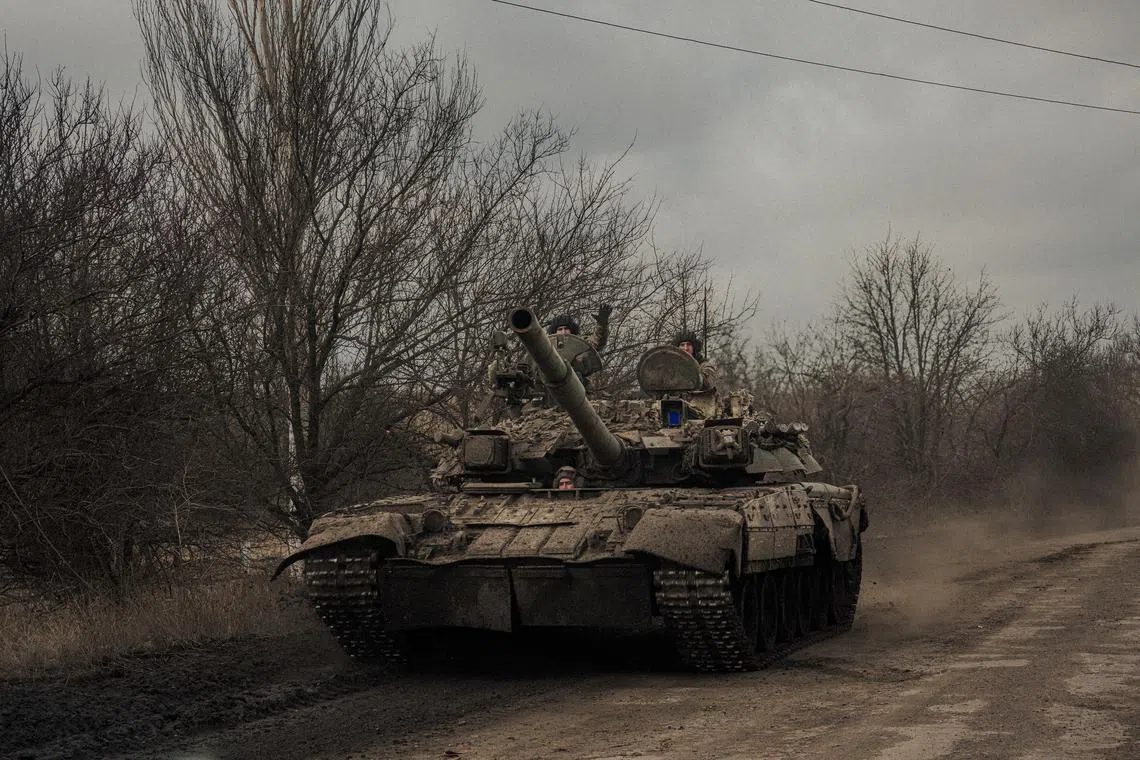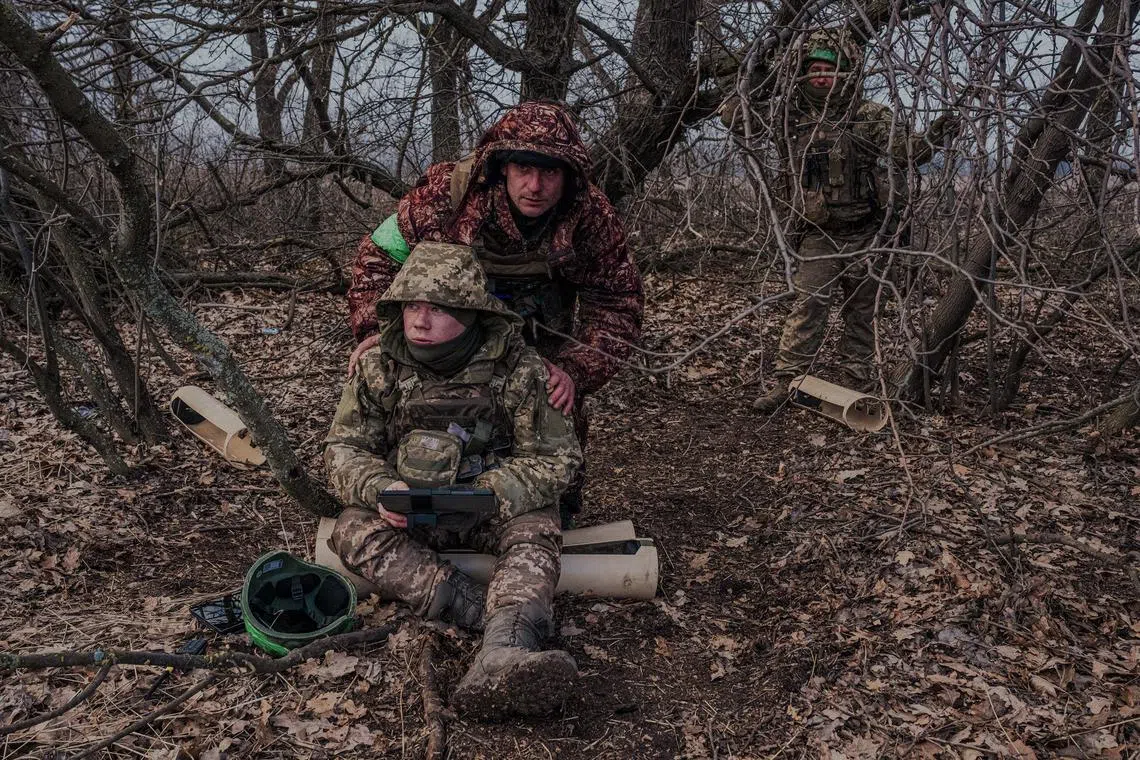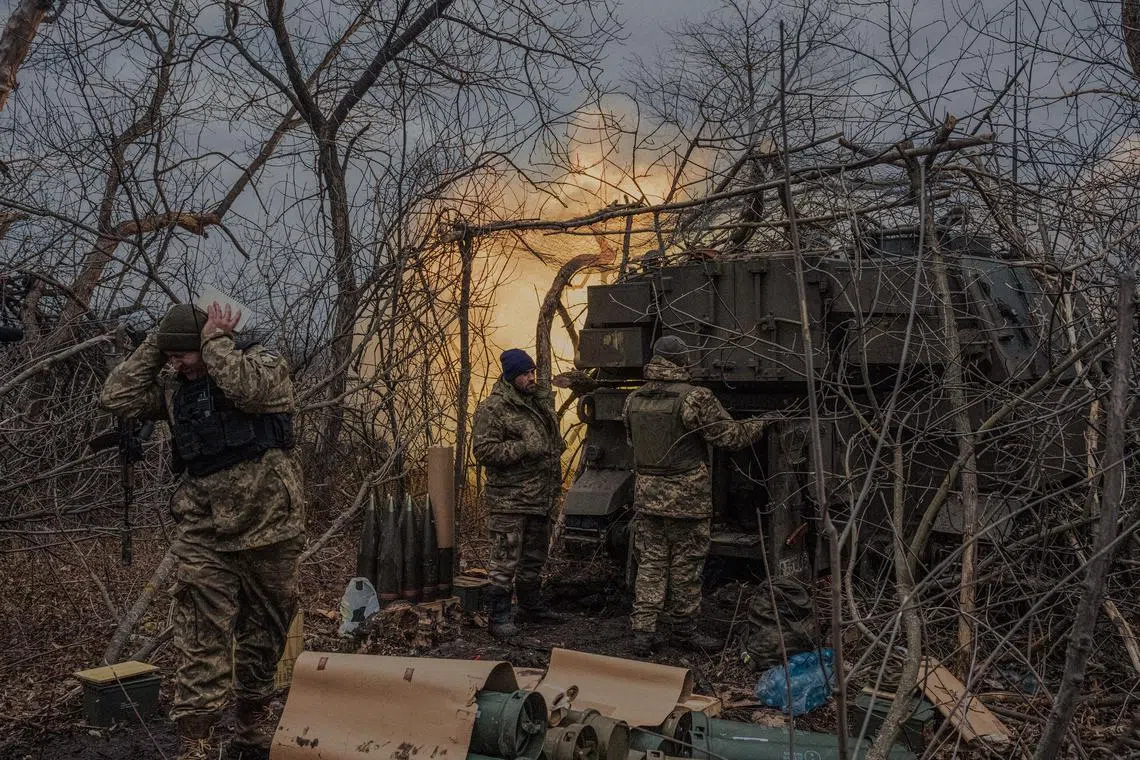Ukrainian soldiers, nearly encircled in Bakhmut, push Russians back
Sign up now: Get ST's newsletters delivered to your inbox

Ukrainian soldiers riding a tank heading towards the frontline near Bakhmut, Ukraine, on March 5, 2023.
PHOTO: NYTIMES
Follow topic:
CHASIV YAR, Ukraine – Lined up in the dark in civilian vehicles, lights dimmed, a company of soldiers waited silently at the side of a road. Farther behind, a second company was parked, an occasional light inside a car revealing the face of a soldier. Still farther back, a third company was moving into place.
After months of pitched battle, the fight over the Ukrainian city of Bakhmut
Then, early on Saturday, Ukrainian assault brigades went on the attack.
On the weekend, hundreds of troops joined the counter-offensive, mounting assaults from the ground and pounding Russian positions with artillery from the surrounding hills.
Ukrainian commanders acknowledged that their forces in Bakhmut still faced the risk of encirclement, but the fighting on the weekend showed that a military that has surprised the world with its doggedness was not yet ready to give up on Bakhmut. How holding the city might fit in with its broader plans was less clear.
Even before Ukraine stepped up its attack on Russians in Bakhmut on the weekend, its forces had moved to beat Russian troops back from the last main highway into the city.
That preserved both a supply line that has helped Ukrainian soldiers tie down the Russian offensive for months and an exit route for them should they decide to retreat.
“I’m confident Bakhmut will hold,” said Colonel Yevhen Mezhevikin, commander of a combined tactical group fighting in Bakhmut.
“We have enough forces to throw the enemy back from this city, but it depends on the tasks the command has, be it holding the city, or inflicting maximum losses on the enemy.”
Other soldiers on the field seem far less confident.
Bakhmut, a city with a pre-war population of 70,000 inhabitants, has little strategic value. It was simply the next in the line of fire of a Russian offensive to seize the eastern province of Donetsk.
But the battle for the city has created a defining moment of the war for both the Russian and the Ukrainian armies.
No longer is the fight about Bakhmut: It is a marathon contest to see which army can break the other.
Russia has thrown tens of thousands of newly mobilised troops into a huge ground assault to take the city by sheer force of fire and manpower.
Ukraine has used every hard-learned tactic from a year of war to hold ground and inflict maximum casualties on the invader, often battling from house to house in neighbourhoods of smashed houses and stunted trees.
Ukrainian troops have steadily lost ground, ceding outlying villages and suburbs in recent weeks. And late winter has been particularly punishing.
Weeks of freezing temperatures and now the onset of the mud season have sapped their strength, soldiers said.
“The fog is constant. Every night, we see almost nothing,” the commander of a combat drone unit attached to the 59th brigade, who goes by the code name Madyar, said in a video message from the front.
“The temperature is above zero for a third day,” he added.
“Everything melted. Mud up to the knee. Rain 10 times a day. Makes it difficult to perform tactical tasks.”
Late last week, Madyar said his unit was pulling out. Other units have, as well.
It remains unclear if the movements were part of a rotation or of a controlled withdrawal.

Ukrainian commanders acknowledged that their forces in Bakhmut still faced the risk of encirclement.
PHOTO: NYTIMES
Unrelenting assault
In one nearby town, Chasiv Yar, the terrifying power of the Russian assault is unmistakable.
Shops and homes are boarded up and the streets are deserted save for a few civilians carrying plastic shopping bags.
Ear-splitting explosions sounded almost constantly on recent visits as Ukrainian artillery fired on Russian positions in and around Bakhmut and Russian guns returned fire.
One woman, Lena, walking home with her shopping on Saturday afternoon, ignored the explosions and barely glanced at unexploded rockets sticking out of the asphalt.
“My daughter left, but I stayed,” she said.
“It’s home,” she said in explanation.
Others are getting out.
Early one morning last week, rescue workers from the Save Ukraine charity raced in to evacuate some of the last residents in a particularly exposed neighbourhood near the canal.
They brought out one couple – Viktor, 73, and Lyudmila, 67 – who fled their home after their neighbour’s house was hit by a shell.
A second couple declined to go. The husband said his wife was ailing with stomach pain.

Ukrainian soldiers fire artillery rounds toward a Russian infantry position near Bakhmut, Ukraine, on March 3, 2023.
PHOTO: NYTIMES
Ukrainian army units are spread out across the undulating hills that stretch for kilometres around Chasiv Yar and Bakhmut.
Artillery guns and tanks are ranged in the tree lines, and soldiers are dispersed in private houses, their vehicles hidden under camouflage nets or behind buildings.
Overhead, Ukrainian jets fly occasionally, often heading in the morning on sorties towards the front line. But this is predominantly an artillery war.
“We repel 15 to 20 attacks a day,” said Vladyslav, 26, commander of a self-propelled artillery battery positioned 6km or 8km from the outskirts of Bakhmut. “Today, it is going more or less fine,” he said cheerfully.
The tempo of artillery fire has been extraordinary.
“On average, we fire 80 to 120 shells a day,” Vladyslav said. “In 1½ months, we fired more than 5,000 shells.”
But artillery ammunition is running low – a problem that senior commanders say helps explain their steady loss of ground.
“There is a shortage,” Col Mezhevikin said. “I would like more people, more vehicles, more ammunition to destroy the enemy on the approaches and his reserves, so our people would have fewer losses and not have such intense fighting.”
Units have had to learn to be judicious with their ammunition, said Major Olexander Pantsyrny, commander of the Aidar assault battalion, a renowned fighting unit.
“It’s constant planning, calculation of ammunition consumption.” NYTIMES

